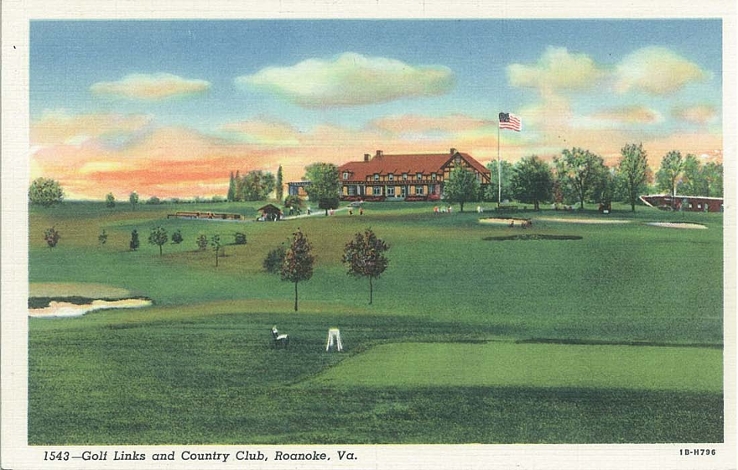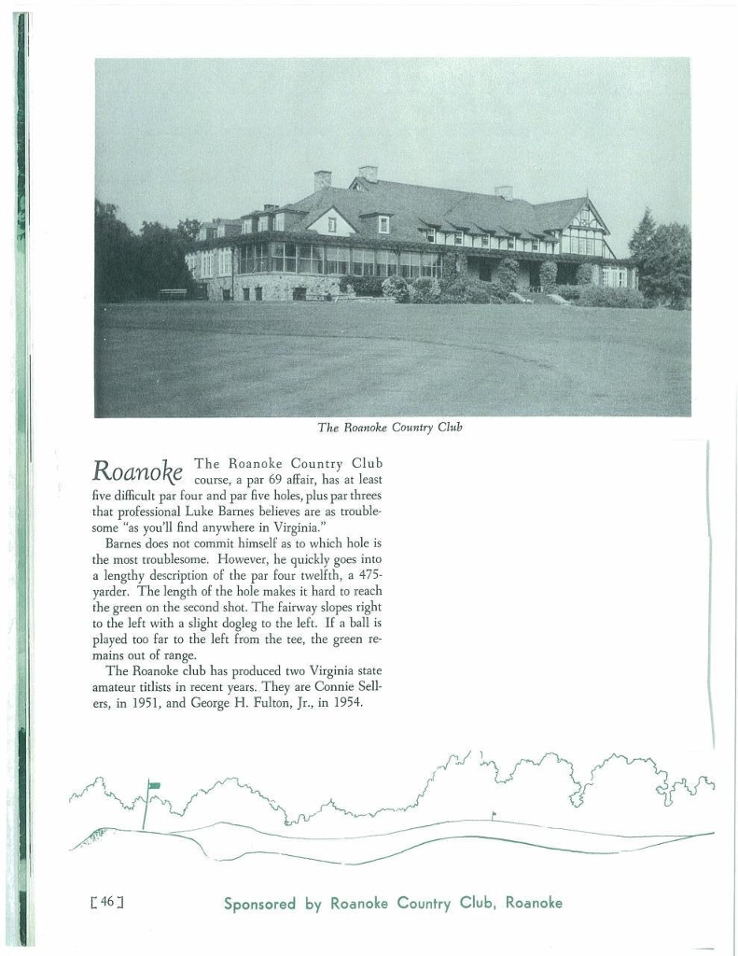For over 125 years, Roanoke Country Club has remained a traditional, family-oriented private club with a proud history.
Since 1899, Roanoke Country Club has offered its members the most prestigious private club amenities. As a member, you will enjoy a 27 hole golf course, designed by A.W. Tillinghast, the largest indoor and outdoor tennis facility in the Roanoke Valley, our newly renovated pool area, and excellent dining in the Terrace Grille and Tillinghast Grill, both with expansive views overlooking our golf course.

In the year 1899, Mr. R.P.C Sanderson, an Englishman, introduced to Roanoke a collection of queer and freakish looking shinny” sticks. He explained to the curious that instead of a general scramble between two opposing side to swat one ball across a goal line, that each player used his own ball in an endeavor to entice it into some tin cups surreptitiously hidden in a pasture lot. The mysteries of the driver, brassie, mashie, jigger, niblick and putter were unfolded to an amazed and credulous audience. The curious liked, listened, and—‘got the bug’. And so it came to pass that the Roanoke Golf Club was formed—. So was written many years ago in the Roanoke World News (4/23/1924) by one of the original founders of the club, Walter A. Carpenter. Roanoke Country Club traces its history to March 1899 with the association of a golf group, which played on a rudimentary course in South Roanoke, and tennis groups with two courts just off Franklin Road near the present Christ Episcopal Church. Roanoke Country Club" whose certificate of incorporation recorded on November 3, 1900 included the stated purposes of ”golf, tennis, gunning and other games and sports" succeeded this unincorporated association. In 1901 the Club purchased property just northeast of the present South Roanoke fire station, consisting of a remodeled frame Club House and six adjoining lots with a bowling alley and other out buildings. The golf links were located on adjoining land leased from The Crystal Spring Land Company at $30 per year. The first club professional, a Mr. Croke of Waterbury, Connecticut, was hired for four months in the summer of 1903.
In 1905 the Club purchased the Frantz farm on Peters Creek Road two miles east of Salem but shortly thereafter sold that property and acquired 53 acres of the Moomaw farm (present site). In 1907 a new corporation, The Roanoke Country Club, Inc.,” was organized and acquired the assets and membership of the former organization. T. S. Davant was elected president. In February 1908, the Club’s Building Committee, chaired by Ernest Fishburn, was charged with construction of new buildings, a nine-hole golf course and tennis courts on the Moomaw property. The Club acquired a 30-foot right-of-way (now Old Country Club Road) through the John A. Taylor property to the Street Railway near Fairview Station along with an acre of Taylor grove land for the site of the Club House. The Club engaged Alexander Findlay, a professional golfer who had immigrated from Scotland in 1887, to design the original nine hole course. [Findlay is credited with the design of numerous courses, including Siasconset Golf Club on Nantucket, and participated in an exhibition tour of the U.S. with famous professional golfer Harry Vardon in 1900. Findlay’s brother Fred designed the James River Course at CCV (1925); Boonesboro CC (1927); and Farmington CC (1928).]
A new Club House, two tennis courts and a nine-hole golf course were completed in 1908. Four new tennis courts were added in 1913 and the original two courts were hard surfaced and lighted in 1915. The Club subsequently acquired property to expand the golf course and in 1919 engaged famed golf architect A. W. Tillie” Tillinghast to design an eighteen-hole course that opened about 1920. In total Tillinghast designed or remodeled 15 U.S. Open and PGA Championship golf courses, including Baltusrol, Bethpage Black, Winged Foot, and Quaker Ridge, as well as the course at Ridgewood for the 1935 Ryder Cup. In 1923 the Club approved plans for a new Club House prepared by architects Smithey & Tardy, with assistance of Robert M. Allen. The new Club House, constructed at a cost of $67,300 on the site of the four tennis courts on the hill overlooking the golf course, was completed in 1924. In 1937 the first swimming pool was completed at a cost of $20,000 and in 1940 10 new Lanite-surfaced” tennis courts were built. In 1941 George Lyman of Oberlin, Ohio, was hired as the first tennis pro and introduced to the membership by refereeing an exhibition match at the Club in May 1941 between a well-known professional Fred Perry of England and Johnny Faunce of California.
In 1948 the Club added improvements to the Club House, including a modern kitchen, at a cost of $80,000. A sprinkler system on the golf course was completed in 1954 at a cost in excess of $30,000 and in 1956-57 approximately 400 trees were planted on the golf course. In 1964 the Club completed a new swimming pool and acquired the Densmore property for an additional nine holes. The new nine, designed by Ellis Maples, opened in 1966. At the same time a chain link fence enclosed the entire course and 100 white pines were planted along the fence on the 8th fairway of the Dogwood Nine and 500 long-leaf pines were planted in the rough of the new nine.
In 1967-68 the Club House was again expanded and modernized at a cost in excess of $400,000; an indoor tennis facility was constructed; and the Club acquired additional land between the Club’s property and Melrose Avenue for $105,000. In the early 1980's the Club hired Tom Clark to supervise the addition of a fourth set of tees (red), repositioning of certain greens (Redbud #3 and Dogwood #4), and improvements to drainage of the course. Additional indoor tennis courts were added in 1995 and swimming pool improvements/renovations were undertaken in 1991 and 1997. To commemorate its Centennial Celebration in 1999, the Club embarked on an ambitious facilities improvement project including a major renovation/addition to the Club House completed in 2000 and the addition of the pond and renovation of greens and tees on the Dogwood nine under the supervision of Lester George completed in 2002.
The Club was a founding member of the VSGA in 1904 and over the years has hosted many of their championships, including three State Open and three State Amateur championships [1915-won by Matthew Paxton of Lexington; 1974-won by Curtis Strange of Virginia Beach; and the 2004 Centennial championship-won by Billy Hurley of Leesburg]. Three Club members have won the VSGA State Amateur championship: 1924-Paul Jamison; 1951-Connie Sellers; and 1954-George Fulton. Club member Liz Waynick won the VSGA Women’s Amateur in 1981. Since 1984 the Club has hosted the Scott Robertson Memorial tournament which is ranked among the nation’s top junior tournaments. Past winners include PGA tour members Hunter Mahan, Kevin Na and Webb Simpson and LPGA tour member Paula Creamer. Moriya Jutanugarn broke the record in 2011 with a 64 in the second round of the SRM.
The original old course (Tillinghast Rotation) record of 62 is held by Bob Allen. The new course record of 61 for men was set by Corey Gallagher and 65 for ladies held by Miriam Nagl.
After 125 years, The Roanoke Country Club, a founding member of the Virginia State Golf Association in 1904, remains among the premier private clubs in Virginia.
